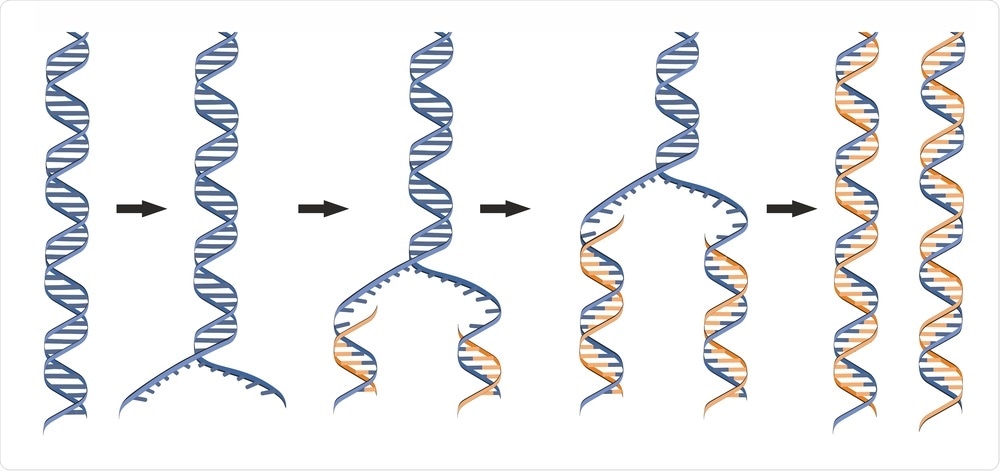Looking deep inside a living cell, researchers from the University of Southern California (USC) discovered a rather surprising aspect—the living cell’s system meant for avoiding genetic damage related to diseases can fail so much that it would be better off without it.

Image Credit: Soleil Nordic/Shutterstock.com
This finding is contradictory because it challenges the concept that tiny protein guardians of cell division continuously provide protection, but the study has demonstrated that they can sometimes allow bad things to occur by merely doing their task too well.
The findings hold major implications in cancer treatment. Moreover, glitches occurring in DNA replication result in other genetic diseases, such as neurological impairments, autism, and birth defects. The ability of a cell to make new cells is equally significant to sustain organs and tissues.
Generally, cells respond to errors during DNA replication by deploying monitoring proteins, called checkpoints that serve to recognize the problem and stop cell division so that chromosome damage is prevented.”
Susan Forsburg, Study Senior Author and Distinguished Professor, Department of Biology, Dornsife College of Letters, Arts and Sciences, University of Southern California
Forsburg continued, “This study makes the unexpected finding that in certain forms of replication stress, an active checkpoint actually allows cells to divide, causing worse damage than if it were missing entirely.”
The study results have appeared in a scientific paper recently published in the Molecular and Cellular Biology journal.
Investigating the aftermath of DNA replication problems
This is an underlying study into the principles of how cells function, how they split to create new cells, and how integrated molecular checks and balances make sure that cell division takes place properly. It is a kind of foundation upon which translational researchers and clinicians can seek better ways to treat various diseases.
Forsburg added, “We are interested in how problems in DNA replication lead to bad things for cells and people, including cancer.”
The researchers used a type of yeast—Schizosaccharomyces pombe—for their study. This yeast has chromosomes analogous to those found in human beings and uses the same kinds of genes to sustain those chromosomes. It has been demonstrated as a significant model for the division of cells.
The analogy I use is comparing a Mercedes and a lawnmower. If you’re trying to understand the basic principles of an internal combustion engine, the lawnmower is a simplified version of the Mercedes engine. The yeast uses the same genes we do, and every gene we study has a human equivalent, with nearly all of them linked to cancer.”
Susan Forsburg, Study Senior Author and Distinguished Professor, Department of Biology, Dornsife College of Letters, Arts and Sciences, University of Southern California
During the study, the researchers analyzed how cells react to a defect managed by an essential gene known as CDS1. Working similar to a guardian for the DNA replication process, it has an analog in human beings known as CHEK1. The gene does a checkpoint by making sure that the DNA is easily copied prior to cell division.
Generally, when something goes awry that inhibits the replication of DNA, the gene prevents cells from dividing until they can overcome the issue. Else, cells would divide without the correctly replicated DNA, which can lead to serious consequences.
Cancer treatments usually integrate medications that prevent the replication of DNA with compounds that hinder the checkpoint, such as a poison pill to force the tumor cells into a deadly division. This research identified a condition where that poison pill actually backfires.
We found that the active checkpoint actually allowed the cells to divide abnormally. Unexpectedly, when we deleted the replication checkpoint, the mutant cells didn’t divide because another damage control mechanism kicked in to stop the unwanted cell divisions.”
Susan Forsburg, Study Senior Author and Distinguished Professor, Department of Biology, Dornsife College of Letters, Arts and Sciences, University of Southern California
The study could offer a deeper understanding of cells and better treatments for cancer.
It is not known how a gene that maintains the health of the cells actually messes up so badly that it causes harm to the organ or tissue. In specific cases, it appears that the checkpoint gets blindsided and pursues its task when it would be better if it took the day off.
“Our experiments examined a very specific defect in DNA replication, and it appears that this created a perfect storm. The checkpoint didn’t know what to do with it. Its best effort to protect the cells actually allowed them to slip into lethal divisions,” Forsburg concluded.
Source:
Journal reference:
Waku, T., et al. (2020) NFE2L1 and NFE2L3 Complementarily Maintain Basal Proteasome Activity in Cancer Cells through CPEB3-Mediated Translational Repression. Molecular and Cellular Biology. doi.org/10.1128/MCB.00010-20.